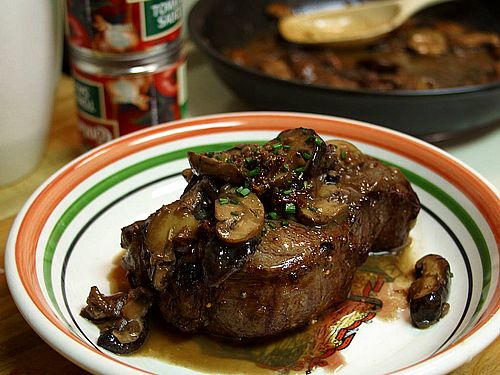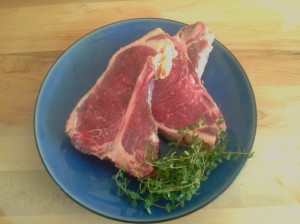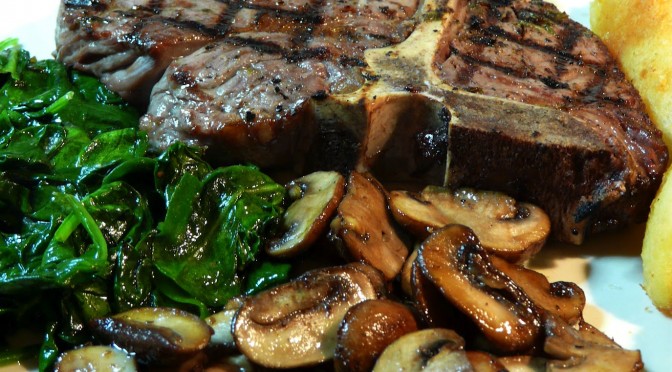Cooking Grass Fed Beef
Don’t Over Cook the Meat – Your biggest culprit for tough grass fed beef is overcooking. This beef is made for rare to medium rare cooking. If you like well done beef, cooking grass fed beef at very low temperatures in a sauce to add moisture is beneficial.
 Oil -Since grass fed beef is extremely low in fat, coat with virgin olive oil, truffle oil or a favorite light oil for flavor enhancement and easy browning. The oil will, also, prevent drying and sticking.
Oil -Since grass fed beef is extremely low in fat, coat with virgin olive oil, truffle oil or a favorite light oil for flavor enhancement and easy browning. The oil will, also, prevent drying and sticking.
Tenderize – Season liberally with kosher or Himalayan (medium course) salt on both sides with kosher or sea salt. If you are used to using regular table salt, this may look like a ton of salt, but just remember that kosher and sea salt flakes are 2-3x the size of table salt.
Marinate – Marinating your beef before cooking especially lean cuts like NY Strip and Sirloin Steak. A favorite marinade using lemon, vinegar, wine, beer or bourbon is a great choice. Some people use their favorite Italian salad dressing. For safe handling, always marinate in the refrigerator.
Add a Rub – If you do not have time to marinate and don’t own a Jaccard meat tenderizer, just coat your thawed steak with your favorite rub, place on a solid surface, cover with plastic and pound your steak a few times to break down the connective tissue. As an added benefit your favorite rub will be pushed into your grass fed beef. Don’t go overboard and flatten your beef unless your recipe calls for it. If you don’t have a meat mallet, use a rolling pin or whatever you feel is safe and convenient.
Stove top cooking is great for any type of steak . . . including grass fed steak. You have more control over the temperature than on the grill. You can use butter in the final minutes when the heat is low to carry the taste of fresh garlic through the meat just like steak chefs.
Remove from Heat Early – Grass fed beef has high protein and low fat levels, the beef will usually require 30% less cooking time and will continue to cook when removed from heat. For this reason, remove the beef from your heat source 10 degrees before it reaches the desired temperature.
Test the Temperature – Use a thermometer to test for doneness and watch the thermometer carefully. Since grass fed beef cooks so quickly, your beef can go from perfectly cooked to overcooked in less than a minute.
Rest Your Meat – Let the beef sit covered and in a warm place for 8 to 10 minutes after removing from heat to let the juices redistribute.
Tongs Only! Never use a fork to turn your beef . . . precious juices will be lost. Always use tongs.
Lower the Temperature – Reduce the temperature of your grass fed beef recipes by 50 degrees i.e. 275 degrees for roasting or at the lowest heat setting in a crock pot. The cooking time will still be the same or slightly shorter even at the lower temperature. Again . . . watch your meat thermometer and don’t overcook your meat. Use moisture from sauces to add to the tenderness when cooking your roast.
Microwave is a No No – Never use a microwave to thaw your grass fed beef. Either thaw your beef in the refrigerator or for quick thawing place your vacuum sealed package in water for a few minutes.
Prepare your Meat for Cooking – Bring your grass fed meat to room temperature before cooking . . . do not cook it cold straight from a refrigerator.
Preheat then Sear- Always pre-heat your oven, pan or grill before cooking grass fed beef. When grilling,

sear the meat quickly over a high heat on each side to seal in its natural juices and then reduce the heat to a medium or low to finish the cooking process. Also, baste to add moisture throughout the grilling process. Don’t forget grass fed beef requires 30% less cooking time so watch your thermometer and don’t leave your steaks unattended.
Roasting – When roasting, sear the beef first to lock in the juices and then place in a pre-heated oven. Save your leftovers . . . roasted grass fed beef slices make great healthy luncheon meats with no additives or preservatives.
Add Moisture -When preparing hamburgers on the grill, use caramelized onions, olives or roasted peppers to add low fat moisture to the meat while cooking. Make sure you do not overcook your burgers . . . 30% less cooking time is required.

